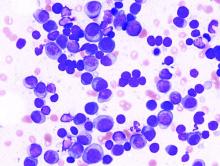Selinexor plus low-dose dexamethasone can produce responses in patients with triple-class refractory multiple myeloma, according to the phase 2 STORM trial.
The combination produced a response rate of 26% in patients who were refractory to at least one proteasome inhibitor, one immunomodulatory agent, and daratumumab.
The most common grade 3/4 adverse events in this trial were thrombocytopenia (59%), anemia (44%), hyponatremia (22%), and neutropenia (21%).
Ajai Chari, MD, of the Mount Sinai School of Medicine, New York, and colleagues reported these results in the New England Journal of Medicine.
The STORM trial included 123 patients with multiple myeloma who had previously received bortezomib, carfilzomib, lenalidomide, pomalidomide, daratumumab, and an alkylating agent. Their disease was refractory to at least one proteasome inhibitor, one immunomodulatory drug, and daratumumab.
The patients had received a median of 7 (range, 3-18) prior treatment regimens, and their median time since diagnosis was 6.6 years (range, 1.1-23.4 years). The median age at baseline was 65.2 years (range, 40-86 years), 58% of patients were men, and 53% had high-risk cytogenetics. In addition, 36% of patients had thrombocytopenia and 16% had neutropenia at baseline.
The patients received oral selinexor at 80 mg twice weekly plus dexamethasone at 20 mg twice weekly until disease progression, death, or discontinuation. Doses were modified in response to adverse events.
Results
In total, 96% of patients (118/123) discontinued treatment. The most common reasons for discontinuation were disease progression (n = 65) and adverse events (n = 38).
Of the 122 patients evaluable for efficacy, 26% achieved a partial response or better, and 39% had a minimal response or better. There were 24 partial responses, 16 minimal responses, 6 very good partial responses, and 2 stringent complete responses. Forty-eight patients had stable disease.
The median duration of response was 4.4 months, the median progression-free survival was 3.7 months, and the median overall survival was 8.6 months.
The median overall survival was 15.6 months in responders, 5.9 months in patients with stable disease, and 1.7 months in those who progressed.
All 123 patients were evaluable for safety, and 63% of them experienced serious adverse events. Pneumonia (11%) and sepsis (9%) were the most common serious events.
The most common treatment-emergent nonhematologic adverse events were fatigue (73%), nausea (72%), decreased appetite (56%), decreased weight (50%), diarrhea (46%), vomiting (38%), hyponatremia (37%), upper respiratory tract infection (23%), constipation (22%), and dyspnea (22%).
Treatment-emergent hematologic adverse events included thrombocytopenia (73%), anemia (67%), neutropenia (40%), leukopenia (33%), and lymphopenia (16%).
Eighty percent of patients had adverse events leading to dose modification or interruption. The most common of these were thrombocytopenia (43%), fatigue (16%), and neutropenia (11%).
“Because most patients involved in the study were older and frail, with limited end-organ reserve and at increased risk for adverse events, dose modifications were anticipated and were specified along with supportive care in the protocol,” the researchers wrote.
“The adverse events that were observed in the study were a function of dose, schedule, and baseline clinical characteristics (e.g., cytopenias). Thrombocytopenia … was reversible and was managed with dose interruptions and thrombopoietin-receptor agonists.”
There were 28 deaths on study, with 16 patients dying of disease progression and 12 dying from an adverse event. Two of the fatal adverse events were considered treatment related – sepsis in one patient and pneumonia with concurrent disease progression in another patient.
The researchers reported ties with Karyopharm Therapeutics, which sponsored the study, and many other companies.
SOURCE: Chari A et al. N Engl J Med 2019;381:727-38.


